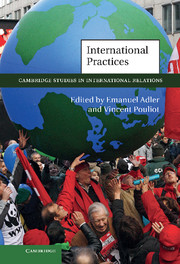Book contents
- Frontmatter
- Contents
- Figure
- Note on the contributors
- Acronyms and abbreviations
- Part I Practices in International Relations and social theory
- Part II Practices and their background
- Part III The evolution of practices
- 6 The practice of deterrence
- 7 Britain’s response to the Spanish Civil War
- 8 Domestic practices and balancing
- Part IV Practices in practice
- Part V Conclusion
- Index
- References
6 - The practice of deterrence
from Part III - The evolution of practices
Published online by Cambridge University Press: 05 June 2012
- Frontmatter
- Contents
- Figure
- Note on the contributors
- Acronyms and abbreviations
- Part I Practices in International Relations and social theory
- Part II Practices and their background
- Part III The evolution of practices
- 6 The practice of deterrence
- 7 Britain’s response to the Spanish Civil War
- 8 Domestic practices and balancing
- Part IV Practices in practice
- Part V Conclusion
- Index
- References
Summary
It is often suggested that deterrence has changed since the Cold War. As to how, commonly mentioned is that how the targets think has changed in many instances – the opponent may be irrational or rational in ways hard for a would-be deterrer to appreciate. Also suggested is that the opponent’s motivation is now often such that threats of grave harm will not deter, or that he has too few “assets” to hold at risk for effective deterrence.
In this chapter, I suggest that while these explanations may be correct they are too narrow and can be enriched by emphasizing that deterrence is always shaped by the political and cultural context in which it operates, as well as by the participants involved and the patterns of behavior they display, that is by practice. It is lodged within and conducted with reference to:
The nature, dimensions, and motivations of the actors involved in the relevant conflicts
The behavioral patterns displayed, deriving in part from participants’ typical prior experiences
The practices which go into shaping deterrence in theory and application, and how they evolve over time
The nature of what officials and military personnel have to work with – equipment, technology, doctrine – in pursuing deterrence.
During the early Cold War, deterrence was primarily explored and explained by development of a comprehensive theoretical approach. This approach initially reflected abstract analysis and only later drew on empirical studies. It was eventually refined and critiqued by examinations of the decision-making, dynamics, and outcomes in various cases of either deterrence or comparable behavior in compellence and other forms of coercive diplomacy. However, as it is a complex social activity, understanding deterrence is enhanced by treating major sustained instances as somewhat distinctive phenomena historically, socially, and culturally – by considering deterrence as varying from case to case. Hence the conception and application of deterrence during the Cold War is necessarily not comprehensively applicable to other deterrence relationships. Practice varies, changes, evolves.
- Type
- Chapter
- Information
- International Practices , pp. 139 - 173Publisher: Cambridge University PressPrint publication year: 2011
References
- 9
- Cited by



